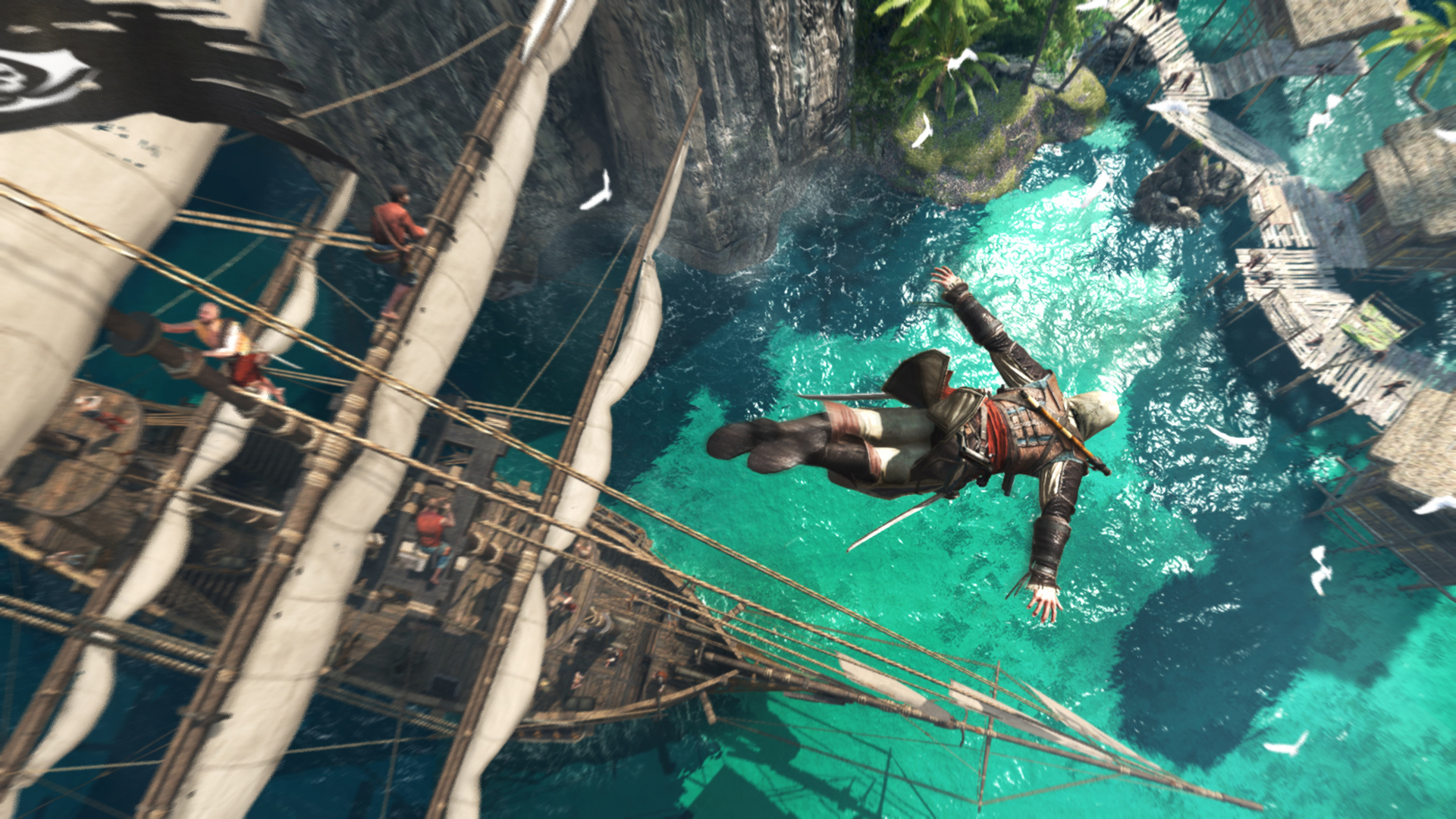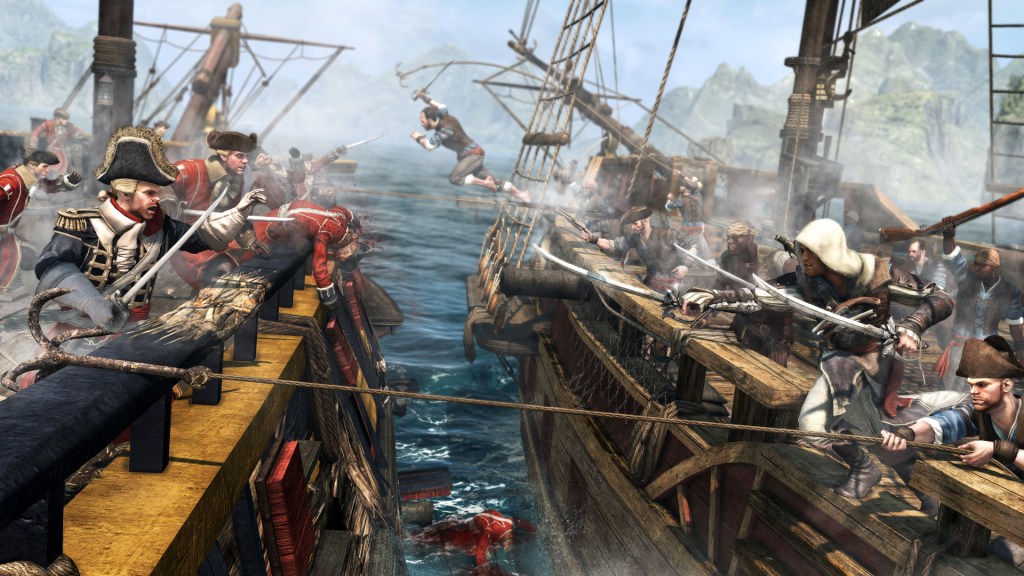Cast off, set sail.
I hate pirates. They're loud. They're stinky. They drink too much and heave salty barf chunks after over indulging with their beloved rum. They're unclean, unwashed, and unruly. Obviously I've spent too much time debating Ninjas vs Pirates with friends, but that side of me will clash dramatically with my love for Ubisoft's historical-science-fiction series in Assassin's Creed IV Black Flag, which moves from colonial America to the Caribbean. We were introduced to Edward Kenway, grandfather of ACIII's Connor Kenway, and heartthrob pirate earlier this year, but it's important to note that Edward coexists with another equally important character: your pirate ship, the Jackdaw.
It's not often that a developer will hand you the controller months before release with the words "you can go anywhere and do anything you'd like" but that's what happened when Director Ashraf Ismail gave us hands-on time at PAX Prime 2013. Opening the in-game map, you'd be forgiven for being overwhelmed by the sheer volume of objectives available. I could assault a templar fortress, dive underwater for treasure, or take an assassination contract, all within just a few seconds of sailing. I chose to mix land and sea gameplay by accepting the hit on a templar leader, but I was quickly impressed at Ubisoft's willingness to make concessions in service of the player's experience.
The Jackdaw itself has four states of speed. Obviously you can retract the sails and jump right off your ship, but as you accelerate through to cruising speed the camera will shift to give you a dynamic view of the ship and the environment around it. At some point, I'm sure I'll be so mesmerized by the Caribbean landscape that I'll crash right into a small sand bar. Cruising speed itself is one of the conceits that help to keep gameplay seamless, immediate, and most importantly fun. Ismail told us that cruising speed is not actually possible in reality with the size and relatively archaic technology that is a wooden ship, but that the player can move faster through the world in this way. That speed will allow you to engage in any number of objectives, but you'll have to ease off the 17th century gas pedal if you want to start combat.
Black Flag really does let you transition from sailing and naval combat, to diving gameplay and on-land exploration, and back to naval navigation seamlessly, without a single loading screen in between. Those transitions feel super smooth, but it's not the kind of thing you'll notice if you haven't played past Assassin's Creed games recently. It's a feature that seems like it always belonged in the franchise and the open world truly benefits for it. If you're wondering how naval combat has changed since ACIII you won't be disappointed by the huge expansion Ubisoft has built in.
You can fight a wide variety of enemy ships and even pick on fishing boats if you're really mean. You can rotate the camera and whichever weapon is appropriate will be automatically selected with a squeeze of the left trigger. Clockwise from the bow of the ship, I could fire chain shot to cripple an enemy's mast, unleash cannon fire to deal heavy damage, deploy fire barrels to leave a deadly trap for pursuing ships, and, of course, even more cannons. The Jackdaw is also equipped with a mortar shot that requires you to lead the enemy and guess at their heading and speed. All of these elements came together in my assassination contract.
The templar leader was hiding in a cove several hundred meters from my location, so I hit cruising speed and found him around a large island outcropping. The enemy vessel immediately began to flee. Ismail said that if I let him find a sandy shore, the templar would flee his ship and head into port where he'd coerce NPCs to fight me to save his skin. I wasn't about to let that happen though. I opened fire with my cannons and my chain shot, and quickly approached for a boarding. I climbed the Jackdaw's mast and air-assassinated a templar henchman before stringing together several kills with cutlass and pistol. All together the combat controls felt more intuitive and streamlined than in ACIII, but the biggest improvement is easily in boarding an enemy ship.
You can board a weakened enemy's vessel at any time from any direction (so long as you're in range) with a push of the Circle button and the same is true for docking near settlements that have established a wooden platform for visiting ships. You could, of course, jump over the side of your boat and swim for your destination, which even allows for a stealthy attack on an enemy ship, but boarding is too much fun to pass up. Yes, the Jackdaw unrealistically side-winds its way to the dock or target ship, but that's yet another concession the Assassin's Creed team has made to ensure Black Flag's playability and gameplay loop remains addictive and engaging.

I didn't mind it. For all of Assassin's Creed's heavy-handed historicism, it's still a game about ancient aliens, hooded vigilantes, and an oppressive order bent on world domination. Ismail told me later that the AC team has an "8 second rule" of sorts that says if you can search Wikipedia for any of the game's historical facts and find it within 8 seconds of landing on the page, it's gotta stay true to reality. Everything else can be fudged. That's more than enough for me, but I still had too many questions, even after about half an hour of play.
What would the modern-day story entail? We've already learned that the new modern hero is you, but how will infiltrating Abstergo play out? How does the Kenway family change teams twice in three generations? What's it like to ride headlong into a storm and how hard is it for the Jackdaw to emerge unscathed on the other side? We'll find out October 29th when Assassin's Creed IV Black Flag arrives on Xbox 360, PS3, and Wii U. If you can hold out for the next-generation version (and you should because the PS4 version we played at PAX looked drop-dead gorgeous) you'll be able to find Black Flag on both Xbox One and PS4 on launch day.
For details on Assassin's Creed IV Black Flag's collector's edition, click here.







